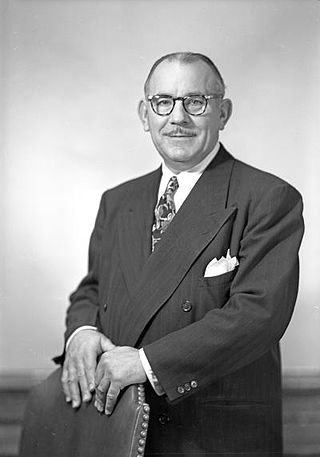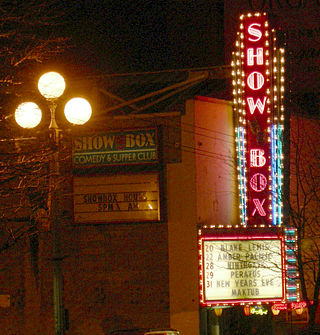
Elliott Bay is a part of the Central Basin region of Puget Sound. It is in the U.S. state of Washington, extending southeastward between West Point in the north and Alki Point in the south. Seattle was founded on this body of water in the 1850s and has since grown to encompass it completely. The waterway it provides to the Pacific Ocean has served as a key element of the city's economy, enabling the Port of Seattle to become one of the busiest ports in the United States.

Belltown is the most densely populated neighborhood in Seattle, Washington, United States, located on the city's downtown waterfront on land that was artificially flattened as part of a regrading project. Formerly a low-rent, semi-industrial arts district, in recent decades it has transformed into a neighborhood of trendy restaurants, boutiques, nightclubs, and residential towers as well as warehouses and art galleries. The area is named after William Nathaniel Bell, on whose land claim the neighborhood was built.

The Cedar River is a river in the U.S. state of Washington. About 45 miles (72 km) long, it originates in the Cascade Range and flows generally west and northwest, emptying into the southern end of Lake Washington. Its upper watershed is a protected area called the Cedar River Watershed, which provides drinking water for the greater Seattle area.

Benjamin Marcus Priteca was a Scottish architect. He is best known for designing theatres for Alexander Pantages.

The Paramount Theatre is a 2,807-seat performing arts venue located at 9th Avenue and Pine Street in the downtown core of Seattle, Washington, United States. The theater originally opened on March 1, 1928, as the Seattle Theatre, with 3,000 seats. It was placed on the National Register of Historic Places on October 9, 1974, and has also been designated a City of Seattle landmark.

Highline High School is a public high school in Burien, Washington, United States, located about 3.5 miles from Seattle–Tacoma International Airport. Highline High School, the flagship high school of the Highline Public Schools district, opened in 1924 and served the cities of Burien, Des Moines, and an area south of Seattle now known as White Center. Today, those cities all have their own area high schools, but at the time Highline was the only high school in the area.

Victor Aloysius Meyers was an American jazz bandleader and politician. He served for 20 years as the 11th Lieutenant Governor of Washington and an additional eight years as the tenth Secretary of State of Washington.

Temple De Hirsch Sinai is a Reform Jewish congregation with campuses in Seattle and nearby Bellevue, Washington, USA. It was formed as a 1971 merger between the earlier Temple De Hirsch and Temple Sinai and is the largest Reform congregation in the Pacific Northwest.

The Showbox is a music venue in Seattle, Washington. It has been owned by AEG Live since 2007.

The Bell Apartments, also known as the Austin A. Bell Building is a historic building located at 2324 1st Avenue in the Belltown neighborhood of Seattle Washington. The building was named for Austin Americus Bell, son of one of Seattle's earliest pioneers, but built under the supervision of his wife Eva following Bell's unexpected suicide in 1889 soon after proposing the building. It was designed with a mix of Richardsonian, Gothic and Italianate design elements by notable northwest architect, Elmer Fisher, who designed many of Seattle's commercial buildings following the Great Seattle fire.

The Bank of California Building is a landmark building located at 815 2nd Avenue in Seattle, Washington. It is located mid-block adjoining the Exchange Building. It was built by the Bank of California in 1924 and has been continually used as a bank ever since. It housed the offices for the Bank of California until 1973 when a new building, the Union Bank of California Center was built at the corner of 4th and Madison Streets. Ironically, this newer, larger building is no longer used as a bank and instead is occupied by a Bartell Drugs store. The original Bank of California Building was retained as a branch office until being sold to the Puget Sound Mutual Savings Bank in 1982 which was headquartered in the building until 1993 when through a series of mergers and acquisitions the bank became a branch of Key Bank, which it remains to present day.
Marcus Charles is an American restaurateur and entrepreneur in Seattle, Washington. He is known for fostering and expanding the Capitol Hill Block Party, resurrecting the Crocodile Cafe music venue, and founding Neumos Crystal Ball Reading Room, along with multiple, successful Seattle bars and restaurants. In 2012, he was a recipient of the Puget Sound Business Journal's "40 Under 40" award.

The Pantages Theatre or Jones Building in Tacoma, Washington was designed by the architect B. Marcus Priteca. The unusual structure opened in January 1918. It was designed to be an office building and a vaudeville theatre. The theater's Second Renaissance Revival style is juxtaposed with the Commercial style. The exterior above the ground floor is largely unaltered. The building still houses entertainment and commercial activities.

The architecture of Seattle, Washington, the largest city in the Pacific Northwest region of the U.S., features elements that predate the arrival of the area's first settlers of European ancestry in the mid-19th century, and has reflected and influenced numerous architectural styles over time. As of the early 21st century, a major construction boom continues to redefine the city's downtown area as well as neighborhoods such as Capitol Hill, Ballard and, perhaps most dramatically, South Lake Union.

Arrivé is a 440-foot (130 m), 41-story skyscraper in the Belltown neighborhood of Seattle, Washington. The $190 million project, originally named Potala Tower after the Potala Palace in Tibet, was designed by Weber Thompson and consists of 342 apartments and a 142-room hotel. It was financed partially by Chinese nationals through the EB-5 visa program and began construction in April 2015.

Spire is a 41-story residential skyscraper in the Belltown neighborhood of Seattle, Washington, United States. The 440-foot (130 m) building sits in a triangular block adjacent to the intersection of Denny Way and Wall Street, roughly between the Belltown and Denny Triangle neighborhoods. It has 343 condominiums, retail space, and a rooftop terrace. The building has an automated parking system in its underground garage with capacity for 266 vehicles.

Ren, stylized as REN and also known as Denny Centre, is a residential high-rise building in the Denny Triangle neighborhood of Seattle, Washington, United States. The 42-story tower has 440 apartments and is located on a triangular lot at the intersection of Denny Way and Fairview Avenue. Construction began in 2018 and was completed in early 2022.

The Langham, Seattle is a future high-rise luxury hotel in Seattle, Washington, United States. It is scheduled to open in 2026 with 187 rooms and suites operated by the Langham Hospitality Group. The 42-story building will incorporate the facade of the Terminal Sales Annex, a historic landmark on the site at 1931 2nd Avenue. The building was designed by Kengo Kuma & Associates and Ankrom Moisan Architects.



















